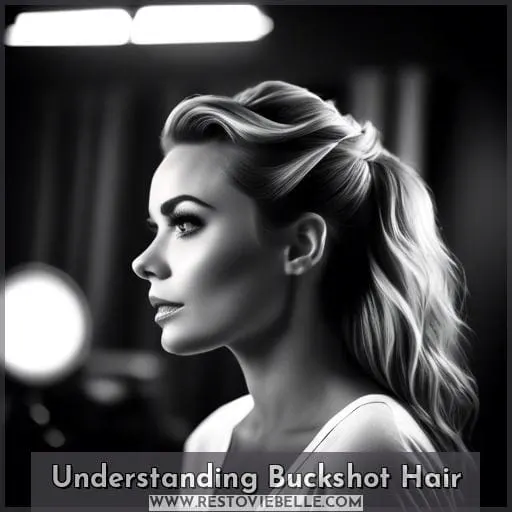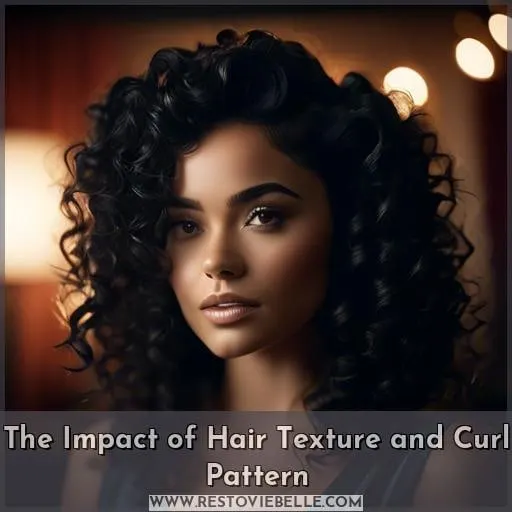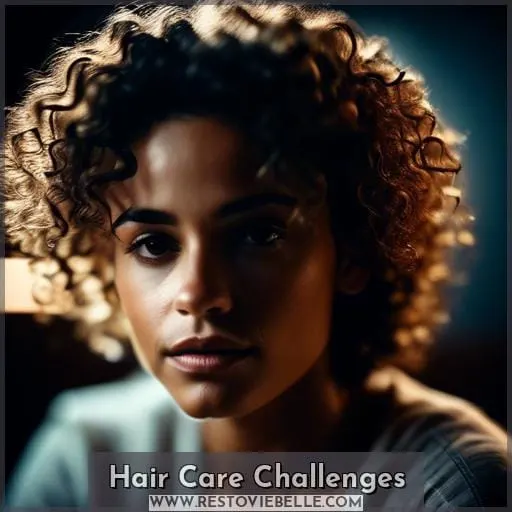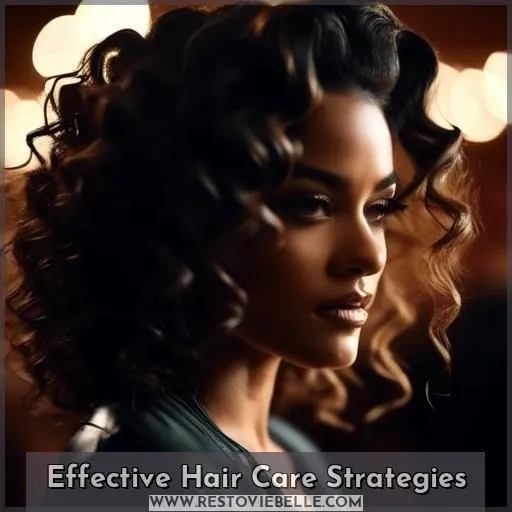This site is supported by our readers. We may earn a commission, at no cost to you, if you purchase through links.
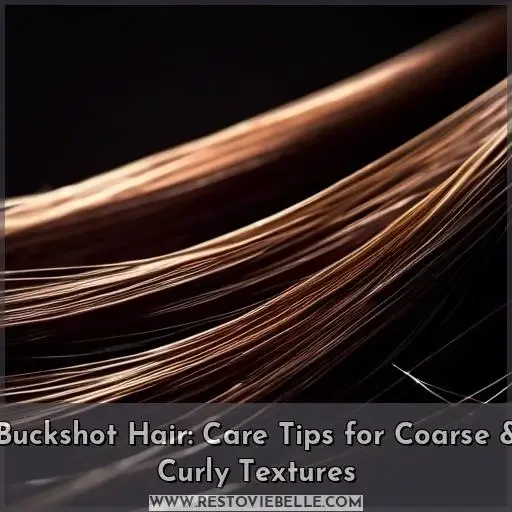
From understanding its causes and characteristics to mastering the art of moisturizing and gentle styling, this article dives deep into the essence of buckshot hair.
Whether you’re struggling with dryness, brittleness, or simply seeking to embrace your natural texture, we’ve got you covered with expert tips and alternative solutions.
Let’s embark on this journey towards achieving healthier, more manageable hair, celebrating the beauty of buckshot hair in all its glory.
Table Of Contents
- Key Takeaways
- Understanding Buckshot Hair
- The Impact of Hair Texture and Curl Pattern
- Hair Care Challenges
- Effective Hair Care Strategies
- Alternative Solutions and Personal Acceptance
- Frequently Asked Questions (FAQs)
- How does the term buckshot hair relate to cultural or societal perceptions, and how might these perceptions influence an individual’s self-esteem or identity?
- Are there any specific dietary or nutritional recommendations that can improve the health and appearance of hair prone to being described as buckshot?
- How does the environment or climate affect buckshot hair, and what preventive measures can be taken to minimize adverse effects?
- Can hormonal imbalances contribute to the condition of buckshot hair, and if so, what are the recommended treatments or interventions?
- What role do genetics play in determining the texture and condition of buckshot hair, and are there any scientific advancements that offer new insights or solutions for managing it?
- Conclusion
Key Takeaways
- Buckshot hair is characterized by coarse, dry, and brittle strands, commonly found in African American communities, and is influenced by factors such as genetics, hormones, age, porosity, and environmental conditions.
- Individuals with buckshot hair often face challenges in hair care, including difficulty in combing and styling due to tangles and knots, susceptibility to split ends and breakage, and a tendency for the hair to lose moisture quickly due to high porosity.
- Effective hair care strategies for managing buckshot hair include using moisturizing products like hydrating shampoos, leave-in conditioners, deep conditioning masks, and natural oils, as well as employing gentle styling techniques and regular detangling methods.
- Alternative solutions to manage buckshot hair involve using gels and scarves, and there is a growing movement towards embracing natural hair textures, which challenges cultural perceptions and promotes a healthier self-image and sustainable hair care practices.
Understanding Buckshot Hair
You might’ve heard the term buckshot hair, which refers to a specific hair condition often found in African American communities.
It’s characterized by coarse, dry, and brittle strands that can appear unkempt or messy, particularly at the nape of the neck.
Understanding the causes and characteristics of buckshot hair is crucial for managing this hair type and maintaining its health.
Definition and Common Names
Buckshot hair, often a term within African American communities, refers to hair that appears unkempt or coarse, with tiny, tightly coiled knots, especially at the nape of the neck.
This descriptor, rooted in cultural perceptions and historical context, reflects the genetic diversity of hair textures.
Factors like hair porosity and environmental elements can exacerbate the condition, making hair seem tough to manage.
It’s a nod to the unique challenges faced by those with highly textured hair, and while it might seem like a tough nut to crack, understanding your hair’s quirks is the first step to taming the mane.
Causes and Characteristics
Buckshot hair, a term often used to describe coarse and curly hair textures, owes its uniqueness to a cocktail of factors.
Genetics play the lead role, handing down the blueprint for your hair’s texture and curl pattern.
Porosity, or your hair’s ability to soak up and retain moisture, adds another layer of complexity, influenced by both your genetic makeup and external factors.
Speaking of external factors, the environment you’re in—be it humid, dry, polluted, or sun-soaked—also has a say in the state of your mane.
So, if you’re navigating the world of buckshot hair, remember, it’s a rich tapestry woven from your genes, the passage of time, and the world around you.
The Impact of Hair Texture and Curl Pattern
Understanding the unique characteristics of buckshot hair, which is often described as coarse, curly, and sometimes challenging to manage, requires a closer look at hair texture and curl pattern.
Different textures can significantly affect the overall health and appearance of your hair, making some hair care practices more beneficial than others.
Similarly, recognizing your specific curl pattern is crucial in selecting the right products and styling techniques to enhance manageability and maintain the hair’s natural beauty.
How Different Textures Affect Buckshot Hair
Your hair’s texture and curl pattern are like a personal fingerprint—unique and influenced by a mix of genetic factors and environmental influences.
- Genetic Factors: Your genes are the blueprint for your hair’s curliness and texture. They determine whether your locks are straight as a runway or coiled like a spring.
- Environmental Influences: The world around you can also shape your hair. Sun, pollution, and humidity aren’t just small talk topics—they can frizz up your hair or weigh down your curls.
- Cultural Practices & Treatments: From the cultural rituals that celebrate your curls to the chemical treatments that straighten them, these practices can alter your hair’s natural state, affecting its porosity and health.
The Role of Curl Pattern in Manageability
As we’ve just explored how different textures influence buckshot hair, let’s dive into the curl pattern’s role in manageability. Your curl shape, from waves to tight coils, significantly impacts how you’ll wrestle or dance with your hair each day.
It’s not just about the aesthetics; it’s about understanding the science behind your strands. Curl patterns affect everything from hair elasticity to moisture retention, and yes, even porosity levels and cuticle alignment play a part.
Here’s a quick guide to help you navigate through:
| Curl Type | Characteristics | Care Tips |
|---|---|---|
| Loose Waves (2A-2C) | Gentle, S-shaped curves; prone to oiliness | Light moisturizers; avoid heavy products |
| Defined Curls (3A-3C) | Springy with defined loops; struggles with frizz | Hydration is key; use defining creams |
| Tight Coils (4A-4C) | Dense, Z-shaped strands; dry and brittle | Rich in moisture; heavy creams and butters |
| Mixed Patterns | Combination of types; uneven texture | Tailored approach; mix and match products |
Hair Care Challenges
Managing buckshot hair, characterized by its coarse and curly texture, presents unique challenges, particularly in combing and styling, as well as maintaining moisture to prevent dryness and brittleness.
The inherent structure of coarse hair makes it less penetrable by moisture, necessitating the use of potent, specially formulated treatments to effectively hydrate and condition the hair.
Moreover, brittle hair, often a symptom of dryness, can result from a variety of factors including over-styling and environmental conditions, highlighting the importance of adopting a gentle, nourishing hair care routine to restore its health and manageability.
Difficulties in Combing and Styling
When tackling the wild frontier of your buckshot hair, you might find combing and styling to be a real bear.
But don’t fret! With the right detangling tools, you can tame the beast.
Start by sectioning hair to make the task less daunting. Wide-toothed combs and finger detangling can be your trusty sidekicks, easing out those knots without a hitch.
And don’t forget, leave-in conditioners are like a trusty steed for your hair’s hydration, making each strand more pliable and ready to face the day.
Keep your mane game strong and your hair’s spirit unbroken!
Issues With Dryness and Brittleness
You know the struggle: your hair feels like a bale of hay rather than a silky mane. Dryness and brittleness are the culprits, turning your tresses into a frizz fest.
- Split ends: They’re not just a sign of hair in distress; they’re a cry for help!
- Tangles: These pesky knots are like a garden of thorns for your comb.
- Breakage: When your hair snaps faster than a twig under a boot, it’s time to take action.
- Scalp dryness: A thirsty scalp leads to thirsty hair, and before you know it, you’re in the desert of dryness.
High hair porosity might be playing a sneaky game here, letting moisture escape as if your hair strands were a sieve.
Effective Hair Care Strategies
When caring for buckshot hair, which is coarse and curly, prioritizing moisture is crucial.
Opting for moisturizing products can significantly enhance the hair’s health and appearance.
Additionally, adopting gentle styling techniques helps prevent damage, ensuring that the hair remains strong and resilient.
These strategies are foundational in managing the unique challenges presented by buckshot hair, promoting a healthier, more manageable mane.
Importance of Moisturizing Products
After tackling the challenges of combing and styling buckshot hair, it’s crucial to understand that the key to maintaining your hair’s health and manageability lies in proper moisturization. Hydrating shampoos, leave-in conditioners, deep conditioning masks, detangling sprays, and natural oils are your arsenal against the dryness and brittleness that often accompany coarse and curly textures.
Here’s a quick guide to help you choose the right products:
| Product Type | Purpose | Usage Tips |
|---|---|---|
| Hydrating Shampoos | To cleanse without stripping natural oils | Use shampoos with nourishing ingredients |
| Leave-in Conditioners | To add moisture and ease detangling | Apply on damp hair, focusing on ends |
| Deep Conditioning Masks | To provide intense hydration and repair damage | Use weekly for best results |
| Detangling Sprays | To ease combing and prevent breakage | Spray on damp hair before styling |
| Natural Oils | To seal in moisture and add shine | Use sparingly on ends or as a pre-shampoo treatment |
Gentle Styling Techniques to Prevent Damage
When it comes to styling your buckshot hair, think of your strands as delicate silk. You wouldn’t manhandle a silk scarf, would you? So, treat your hair with the same tender, loving care.
- Detangling methods: Start with your fingers to gently tease out knots, then follow up with a wide-toothed comb for minimal stress on your curls.
- Wide-toothed combs: These are your best pals for combing through wet hair without causing havoc on your curl pattern.
- Finger combing: Sometimes, your digits are the best tools. They can navigate through tangles with a finesse that combs can’t match.
- Leave-in conditioners: These are like a soothing balm for your hair, providing the slip needed for easier combing and long-lasting hydration.
- Hair oils: A little oil can go a long way. It’s like a secret potion that adds moisture, sheen, and smoothness to your locks.
Alternative Solutions and Personal Acceptance
When managing buckshot hair, incorporating gels and scarves can offer practical solutions for taming and styling coarse and curly textures.
Embracing your natural hair texture, rather than striving for conformity to mainstream beauty standards, can lead to a healthier relationship with your hair and self-image.
This approach not only celebrates the unique beauty of diverse hair types but also encourages a shift towards more sustainable and self-affirming hair care practices.
Use of Gels and Scarves for Management
Navigating the world of buckshot hair, you’ve likely encountered the challenge of keeping those curls in check. Fear not, as gels and scarves come to the rescue, offering a blend of control and style that can make all the difference.
When it comes to gel types, it’s not just about slapping on any old product. The right gel can tame the wildest of curls without leaving you feeling like you’ve got a helmet on your head. Think of it as your curl’s best friend, offering a helping hand in times of need.
As for scarf techniques, they’re not just a fashion statement but a curly hair lifesaver, especially during nighttime routines. Wrapping your hair in a scarf can protect your curls from the chaos of tossing and turning, ensuring you wake up with hair that’s as beautiful as a calm sea after a storm.
Weather influences can turn hair care into a guessing game. On humid days, layering products can be your secret weapon, creating a shield that laughs in the face of frizz. It’s like preparing for battle, and with the right armor, your curls will emerge victorious.
In the end, it’s all about embracing the beauty of your natural texture. Whether it’s through the strategic use of gels, mastering the art of scarf wrapping, or finding the perfect product layering technique, the goal is to celebrate your curls in all their glory.
So, let’s raise a glass (or a gel bottle) to the curls that make us unique, and remember, in the world of hair care, creativity is your greatest tool.
Embracing Natural Hair Texture and Appearance
Embracing your natural hair texture and appearance is like giving a nod to your roots, saying I see you, and you’re beautiful.
- Understand your hair porosity to tailor your care routine.
- Maintain scalp health with gentle, nourishing products.
- Seek out product recommendations for your specific hair type.
- Experiment with protective styles that shield your hair while looking chic.
- Challenge cultural perceptions by rocking your natural texture with pride.
Frequently Asked Questions (FAQs)
How does the term buckshot hair relate to cultural or societal perceptions, and how might these perceptions influence an individual’s self-esteem or identity?
In society, buckshot hair can reflect deep-seated biases, shaping how individuals with tightly coiled hair perceive themselves and are perceived by others.
Are there any specific dietary or nutritional recommendations that can improve the health and appearance of hair prone to being described as buckshot?
To give your hair a fighting chance against the dreaded buckshot look, dive into a diet rich in eggs, leafy greens, and fatty fish.
These aren’t just tasty treats; they’re your mane’s best mates, packed with nutrients that kick hair health up a notch.
How does the environment or climate affect buckshot hair, and what preventive measures can be taken to minimize adverse effects?
Humid or dry climates can dry out your hair, making it brittle.
To shield your locks, use moisturizing products.
Avoid excessive heat styling.
Wear hats to protect against UV rays and pollution.
Can hormonal imbalances contribute to the condition of buckshot hair, and if so, what are the recommended treatments or interventions?
Hormonal imbalances can indeed affect hair health, potentially leading to conditions like buckshot hair.
Treatments may include hormone therapy, lifestyle changes, and targeted medications like minoxidil.
What role do genetics play in determining the texture and condition of buckshot hair, and are there any scientific advancements that offer new insights or solutions for managing it?
Genetics significantly influence hair texture, including the elusive buckshot hair. While you can’t pick your family tree, understanding the genetic roots of your hair’s quirks might just be the next best thing.
Imagine your hair traits as a genetic lottery where genes from your mom and dad mix and match in surprising ways. This genetic cocktail determines whether you’re dealing with curls that defy gravity or strands that are straighter than a ruler.
Recent studies, like the one on the EDAR gene, shed light on how these genetic factors play out, offering hope and new directions for those looking to tame their mane or simply understand it better.
So, while you might blame your parents for your hair’s behavior, science is on the brink of offering more personalized solutions to work with what you’ve inherited.
Conclusion
Just as a gardener nurtures each plant in a diverse garden, understanding and caring for buckshot hair requires a tailored approach.
Embracing your unique hair texture and curl pattern is akin to celebrating the variety of life in a lush, vibrant ecosystem. Buckshot hair, with its coarse and curly nature, may present challenges such as dryness and difficulty in styling, but these can be overcome with the right strategies.
Moisturizing products and gentle styling techniques are your tools for cultivating a healthy hair environment. Remember, the journey to embracing and managing buckshot hair isn’t just about overcoming challenges; it’s about celebrating the natural beauty and strength of your hair.

